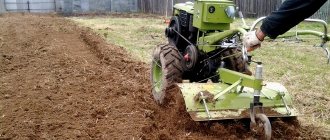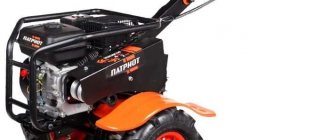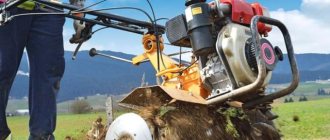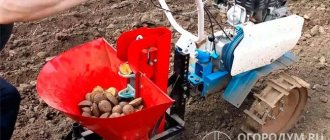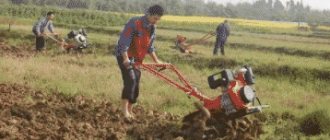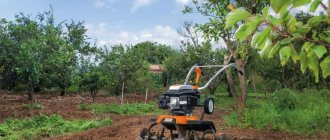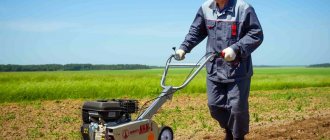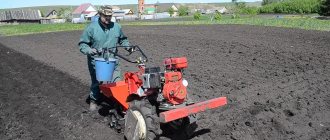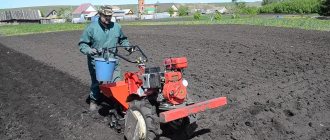When they see such a plot, many people give up: the land hasn’t been cultivated for many years, you can’t stick a shovel into it, everything is overgrown with weeds... You can’t do it without special equipment. Let's figure out which one it is.
In order for the land on a virgin plot to acquire a well-groomed appearance, it is not enough just your persistent motivation and the efforts that you are willing to spend on realizing a grandiose goal. Serious gardening equipment can handle densely packed soil. The choice of the right equipment directly depends on the condition of the soil and the degree of its neglect.
Purpose of the plow
The plow is one of the main means of cultivating the land. Its working cutting part is a ploughshare, which cuts and turns over a layer of earth.
Depending on the adjustment of the position of the ploughshare, plowing can be carried out with incomplete or complete rotation of the formation:
- a full turn (180 degrees) is when the roots of the weeds in the dump are at the top;
- incomplete - the layer rotates 90-120 degrees.
At the same time, the ploughshare cuts the roots of perennial and annual weeds.
Today, no-till technology is increasingly being used. But for the development of virgin, fallow lands, for plowing green manure, and controlling weeds without herbicides, plowing remains an indispensable operation.
By turning over the earth, the plow buries the weed seeds that have fallen over the summer to the surface of the earth to a great depth. Most seed sprouts next year will not be able to break through the layer of soil. The plow also cuts off the roots of perennial root-propagating weeds. As a result, plowed areas become cleaner.
Is the walk-behind tractor suitable for plowing?
Many farmers doubt that this technique is suitable for plowing the soil. There are people who believe that the power of walk-behind tractors is not enough for such work.
In fact, there are units that are quite suitable for plowing vegetable gardens and garden plots with long-untouched soil. Currently, a sufficient number of models of heavy motor cultivators are produced, which are designed specifically for plowing virgin soil.
Motoblock equipment can be used when plowing virgin lands
Preparatory work
Using a walk-behind tractor with a plow, plowing is carried out in dry weather. The soil should not stick to shoes and wheels.
In addition to the obvious preparation (filling with fuel, checking the oil level, tension and condition of the belts), the installation of wheels is necessary. If the kit includes metal lug wheels, install them. Another option is large-diameter wheels with “agricultural” tires (herringbone tread).
The ploughshare itself must be clean and smooth, the cutting edge must be sharp. If it is dirty or dull, clean it with sandpaper. Sharpening is carried out with abrasive wheels on a sharpening machine or with a monkey.
Test plowing is done. The depth is checked. If necessary, correct by raising or lowering the share.
When plowing the first row, the walk-behind tractor with the plow is strongly pulled to the side. The second furrow goes easier, since the wheel goes along the ditch. The first furrow is sometimes plowed along a cord stretched on pegs across the entire area. This makes it possible to navigate.
In what cases does it make sense to purchase a motor-cultivator, and in which case - a walk-behind tractor?
The first unit is intended only for cultivating soil using cutters.
And although some models allow the use of other attachments, nevertheless, these attachments are designed only for soil cultivation, and, in addition, due to the low weight of the motor cultivator, performing serious excavation work with it is tiring for the operator. Walk-behind tractors are units with a wide range of attachments: a plow, hiller, cultivator, snow blower, broom, hay and lawn mower, trailer, etc. That is, they are used to solve a wide variety of tasks throughout the year. They are heavier and more powerful than motor cultivators, so they are better suited for plowing virgin soil and other earthworks. What attachments not related to land cultivation can be purchased?
There are nozzles for cutting grass - segmental (frontal) or rotary mowers.
Segmental
- a traditional solution, they consist of two blades with sharpened teeth, one of which has its own drive (the design resembles a hair clipper).
Rotary mowers
mow vegetation using two cutting discs mounted on the frame. These discs are “floating”, which makes rotary mowers more reliable than segment mowers: having hit an obstacle, the discs do not break (like teeth), but go around it. In addition, unlike a segment mower, a rotary mower places the cut grass in a row, and no additional raking is required to remove it.
Please note that a walk-behind tractor with any type of mower cannot act as a lawn mower.
, since even a slight slip of its wheel with directional tread can lead to damage to the lawn. But such a unit copes well with coarse, high-yield vegetation and can be used for mowing grain crops and even low-growing shrubs.
When the walk-behind tractor is not used for a long time, you should drain the fuel from the engine: over time, gasoline loses its properties, and if this is not done, the engine will stall or run intermittently when starting
Among the attachments for walk-behind tractors are
devices for clearing snow: a shovel (blade), as well as a special snow blower with a rotary auger mechanism
that grabs snow and throws it through a bell to a distance of up to 10 m. As a rule, the width of the snow blower is about 70 cm, the productivity unit - 2500 m²/h. To remove freshly fallen snow up to 10 cm deep, as well as to clean the area from debris, another attachment is provided - a brush 80-100 cm wide.
Walk-behind tractor with trailer
Finally, an accessory that is important for many consumers is a trolley (trailer) with an average load capacity of 300–350 kg, which allows you to transport various loads.
The speed of movement of the car with a trolley is 10–11 km/h.
This is the range of additional accessories for most models of walk-behind tractors. However, for units designed for professional use, other attachments are also available. So, for some models you can find a branch chopper, a hay turner, a special cutter with which you can prepare even rocky virgin soil for planting a lawn in one pass, etc.
One of the advantages of walk-behind tractors is their large weight, from 70 to 170 kg with an attachment, due to which the load on the operator’s arms, shoulders and back is less than when working with a walk-behind cultivator. However, this advantage can also be considered as a disadvantage when it becomes necessary to transport the car from one place to another. However, the assembled 70-kilogram walk-behind tractors are quite compact (all models have removable or folding handles), so they can be transported even in passenger cars.
Plowing rules
Medium and heavy walk-behind tractors are suitable for plowing with a plow; in rare cases, cultivators are used. The correct selection of plowshare sizes is important. For heavy walk-behind tractors (about 100 kg) the ploughshare grip is 23 cm, for medium ones (about 75 kg) – 18 cm.
Work with the plow is carried out in 1st low or high gear, depending on the soil. Light soil (sandstone, sandy loam, developed loose chernozem, gray soil) can be plowed freely in higher gears. Heavy loams and heavily turfed soils are plowed in the lowest gear. This reduces the speed of movement of the walk-behind tractor with the plow, but gives maximum power.
Do not overheat the engine. Over large areas, you need to work intermittently to allow the engine to cool down. This is especially important for new ones that have not yet been broken in. Remember this rule, it will allow you to plow the garden with a walk-behind tractor to the end.
Features of using a walk-behind tractor for plowing
Before you start plowing using this technique, you need to familiarize yourself with the main features of plowing with a walk-behind tractor:
- when plowing virgin soil with a walk-behind tractor, it is better to use models weighing at least 100 kg;
- plowing should be carried out using a special rotary plow with an additional cutter;
- To loosen the soil more efficiently, special weighting agents are installed on the plow.
It is necessary to plow the garden in stages 2-3 times. In this case, each time the plow needs to be deepened more and more. Also read about the features of plowing with a walk-behind tractor and a plow.
Adjustment
To properly plow a plow on a walk-behind tractor, you need precise settings. Below are complete instructions that will help you adjust for easy plowing of the land.
In the attachments for walk-behind tractors there are two similar equipment: a hiller and a reversible plow. Of course, you can’t plow with a hiller. Its shape is such that it makes a blade on two sides, pouring soil onto adjacent furrows to the left and right.
A reversible plow for plowing makes the blade on one side with the formation turned over. Before plowing, the position needs to be adjusted in three positions:
- Plowing depth (ploughshare lowered or raised).
- The angle of inclination of the ploughshare (across the axis of the furrow, affects the degree of rotation of the formation).
- Angle of attack (along the axis of the furrow, position of the share relative to the ground).
For such adjustment, most hinged brackets and walk-behind tractors have holes in different positions and adjustment screws.
First, adjust the position of the ploughshare itself in the bracket (plowing depth). The ploughshare is moved up or down to achieve the desired plowing depth. (15-20 cm).
Then set the position of the bracket with the plow relative to the walk-behind tractor (ploughshare angle). To do this, on most models, in the place where the hinged bracket is attached to the body of the walk-behind tractor, there is the possibility of additional adjustment in depth, as well as setting the angle of inclination. You can do it like this:
- The left wheel is raised on spacers to a height equal to the depth of the intended plowing. For example, 17 cm. At the same time, the fixed plow also tilts.
- Loosen the bolts securing the plow bracket and turn it so that the plowshare is again perpendicular to the ground, at 90 degrees.
The result is something like this:
In addition to adjusting the depth and angle of inclination, adjustment of the angle of attack of the plow is required. This is the angle at which the cutting part of the share enters the ground. The adjustment is carried out using the screw provided for this purpose on the bracket. The average value of this angle is set as follows:
- The walk-behind tractor with the plow is placed on a flat surface so that the ploughshare lies completely on the ground, parallel to it.
- The adjusting screw is used to raise the rear part of the plow so that it rises 2.5 cm above the ground, while the front cutting edge remains on the ground.
This is the most optimal angle of attack for most plows. If problems arise (unusual soil, non-standard plow shape), the angle is changed by trial.
Problems with the wrong angle of attack - the plow buries itself in the ground, the walk-behind tractor does not pull. You need to raise the nose of the ploughshare.
Or, on the contrary, when plowing, the ploughshare jumps up out of the ground; great effort is required to press down on the walk-behind tractor. Then the nose of the ploughshare is lowered.
The adjustment devices on different mounted plows may differ.
The photo shows a plow with screw adjustment of positions:
At the same time, there are no holes on the vertical bar for attaching the plowshare to the bracket to adjust the plowing depth.
These holes are found on the following model:
There are dozens of varieties of mounted plows for walk-behind tractors on sale with different mechanisms and adjustment units. But all of them must be adjusted according to the three positions listed above - plowing depth, angle of inclination relative to the walk-behind tractor, angle of attack. When choosing, you should take into account the possibilities and convenience of such adjustments, as well as the correspondence of the size of the plowshare to the power of the walk-behind tractor.
The plow can be adjusted so precisely that the walk-behind tractor can plow the garden itself, without human intervention. The plowman can only turn it around and direct it into the furrow. An example of such work can be seen in the following video:
The process of perfect tuning can only seem complicated. It's really just making the above adjustments for depth, slope and angle of attack correctly. Plus, the owner of the walk-behind tractor in this video performed two more technical techniques: he made the wheels heavier by 20 kg each and modified the plow, making the upper part of the plow sharp.
In practice, you can do without this by hanging a load on the front of the walk-behind tractor and using standard metal wheels with lugs. The meaning of the sharpening of the upper part of the plow shown in the video, which does not enter the ground and does not cut it, is generally difficult to understand.
Plowing with a walk-behind tractor with metal lug wheels:
In addition to the adjustable parameters (depth, slope and angle of attack), there is another important dimension - the width between the furrows. When plowing, there should be no unplowed strips of land between the furrows.
When plowing, one wheel of the walk-behind tractor, as a rule, goes along the finished plowed furrow. Thus, the width between the furrows is determined by itself. It is equal to the distance from the wheel to the center of the cutting blade and cannot be adjusted. In theory, this distance can be changed by moving the wheel along the axle or changing the position of the attachment of the plow bracket to the walk-behind tractor. In practice, this may only be necessary if a small plow with a narrow grip is used.
Recommendations for plowing
Plowing virgin soil is not an easy job, for which you need to prepare in advance. There are several tips that will help with plowing the site:
- This work should be done in the fall, before the onset of winter frosts;
- Do not immediately drive the plow too deep underground;
- plowing virgin soil with a large amount of grass should be carried out with powerful equipment;
- you need to plow the area in a circle or zigzag;
- It's better to walk the square twice.
Many summer residents are interested in plowing virgin soil. People who want to start plowing a plot should figure out in advance whether it is possible to plow virgin soil with a walk-behind tractor and how to do it correctly.
The video below shows how to take virgin soil with a walk-behind tractor with cutters without straining.
Soil treatment in winter and benefits
You can plow the ground with a walk-behind tractor even in winter; there is nothing wrong with that and medium-power equipment can easily handle even slightly frozen soil. Plowing of the land is divided into autumn (plow) plowing before winter and spring. Depending on the time of implementation, plowing gives different results.
Advantages of plowed land:
- before spring planting, most of the green mass of weeds and fibrous (small) roots of weeds, added organic matter and green manure plowed into the ground have time to rot;
- the plowed land is not harrowed or cultivated. During the winter, large clods of earth are torn apart by internal ice crystals and rain, and by spring they crumble. The earth becomes softer and looser. Spring cultivation breaks up the lumps left after plowing and destroys the hairy shoots of weeds that have managed to sprout, and closes moisture reserves;
- all insect pests, their larvae, prepared to spend the winter in the arable layer, as well as most pathogenic fungi, are raised to the surface and freeze out in winter.
Zyableva is considered to be autumn and late autumn plowing. In fact, you can plow before winter immediately after harvesting, even at the end of summer.
The remaining advantages are common to autumn and spring plowing - general aeration and loosening of the soil, suppression of perennial root weeds, incorporation of fertilizers into the fertile layer, if they were applied.
Why plow the land?
Recently, the question of whether it is necessary to plow the garden is actively discussed, and if so, how best to do it, to what depth, with what devices. There are many different theories, tried and tested, however, the need to plow the soil in the spring still remains beyond doubt.
It is better to do this with the help of such a lightweight compact device as a walk-behind tractor. It has many advantages over manual labor because it works faster, more efficiently and requires less consumption of human physical resources. The walk-behind tractor can perform two tasks - plowing the soil and cultivating it.
The need for plowing arises in the fall or spring, and good owners (as people say) do it twice. The land can be virgin land or an area where crops are grown year after year. The cost of plowing the soil with a walk-behind tractor depends on the type and composition of the soil.
Tips and tricks
It doesn’t always make sense to try to plow as deep as possible with a walk-behind tractor and a plow. Crops with shallow roots deplete the surface layer. The rise of the nutrient layer to the top when plowing is important for them. Other crops have a root system up to 0.7 - 1 m deep; for them, the plowing depth is not so important. 15 cm is enough.
The video shows why the walk-behind tractor moves to the side and how you can solve the problem with incorrect plow settings:
The mechanical properties of the soil are of great importance. Heavy and dense loams, petrified in a dry year, may not be taken at all by the walk-behind plow. Or it will plow, but very hard, turning out large blocks. In this case, you need to wait for optimal humidity. After rain, the soil becomes softer; as soon as the soil stops sticking to your shoes, you can try plowing.
If an island with perennial root-producing plants (wheatgrass, horseradish) appears on a plot of land, it is better not to plow it completely along with the entire plot. Otherwise, the root fragments will be scattered by the plow all over the garden and the area will be clogged.
In this case, the roots of the weeds are selected manually, the area is left until better times or plowed separately, without dragging the roots around the area. It is best to dig such weeds with a regular shovel.
As you can see, in order to properly cultivate a vegetable garden with a walk-behind tractor, you only need a suitable walk-behind cultivator, a properly configured plow and experience.
Processing the area with a tractor
The tractor is suitable for processing large areas
The easiest way to cultivate land covered with wild vegetation is to use a tractor with a plow and harrows. It’s good if you have your own tractor and replacement equipment for it. But not everyone has such serious equipment; most people hire tractor owners to cultivate virgin land.
True, this option is only good for owners of large plots, the conditions of which allow the use of large equipment. But most often, access for heavy equipment is impossible due to narrow streets, numerous outbuildings and trees. In addition, in a small area there is simply no room for the tractor to turn around. Therefore, owners of standard 6 acres have to look for other options.
Is it possible to plow virgin soil with a walk-behind tractor?
Every farmer knows how valuable time is when cultivating the land, sowing or harvesting, therefore, whether plowing virgin soil with a walk-behind tractor is possible is of interest to many. Using a walk-behind tractor in most cases does not raise any questions or difficulties. A lot of information can be found in the instructions that come with each model of equipment. And yet, beginners sometimes have questions. They are often associated with the processing of virgin soil. In order to quickly figure this out, you should find out what the device for plowing the land might be.
How to treat an abandoned site - choosing equipment for virgin soil
Adding an article to a new collection
When they see such a plot, many people give up: the land hasn’t been cultivated for many years, you can’t stick a shovel into it, everything is overgrown with weeds... You can’t do it without special equipment. Let's figure out which one it is.
In order for the land on a virgin plot to acquire a well-groomed appearance, it is not enough just your persistent motivation and the efforts that you are willing to spend on realizing a grandiose goal. Serious gardening equipment can handle densely packed soil. The choice of the right equipment directly depends on the condition of the soil and the degree of its neglect.
